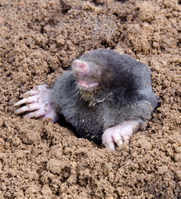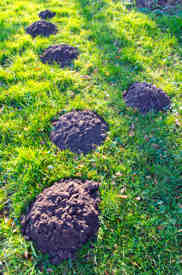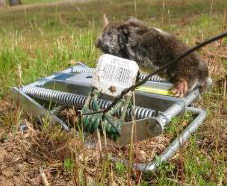
It is legal to use one or more methods kill moles in almost every jurisdiction in the English-speaking world. Some methods, however, are prohibited in some locations, and some methods are prohibited almost everywhere. Fortunately for homeowners, the methods that are unlawful are usually also the methods that do not really work. With the caveat that this article cannot substitute for legal counsel, let’s consider them one by one.
1. Firearms.
When moles dig unsightly mounds across a newly planted lawn or work their way into irritation systems, many homeowners feel a visceral urge to get a shotgun and send the varmints to their eternal reward. While a shotgun blast will indeed kill a mole, and possibly rupture a water line or a gas main or ricochet back to the shooter, firearms are an inefficient way to kill moles—the shooter has to be in position at exactly the right spots for hours on end waiting for the animal to surface—and most cities do not permit discharge from firearms at any time of day or night. Discharging a firearm in your yard in city limits is an iffy proposition for getting rid of moles, but it is a sure-fire way of getting the attention of the police. If you simply must shoot moles, check with your local law enforcement authorities to make sure the use of firearms is legal. And make sure any firearm you own is legally registered before you ask.
2. Insecticides and vermifuges (worm killers).

Sometimes homeowners get the idea that they can starve out their mole infestations by killing the insects on which they feed. One of the major problems with this insecticides is that insects are not the bulk of the food that moles eat. Most moles mostly feed on earthworms. However, killing insects might encourage moles to move to better feeding grounds. Some insecticides, however, are unlawful, and the most common method of killing earthworms has a potentially deadly side effect (for humans).
- Bacillus thuringiensis, also known as milky spore or Bt, is a naturally occurring bacterium that causes grubs to become terminally constipated. It’s a natural product that may be even be used for “organic” or “biological” landscapes, but it will not kill earthworms. Still, if you want to get rid of grubs without using poison, it may be useful. It just won’t get rid of moles. Bt is lawful in almost all jurisdictions in the English speaking except in the capital city of the United States, Washington, D.C.
- Castor oil would kill a mole if the mole actually consumed it. Moles usually leave castor oil and castor beans alone. They are legal in almost all jurisdictions, but if you buy large amounts of castor beans, which contain the deadly poison ricin, to kill moles, you may find yourself on a watch list.
- Diatomaceous earth is essentially ground up chalk. The sharp edges of the tiny crystals of chalk cut the exoskeleton of insects and cause them to lose fluids and dehydrate. When diatamaceous earth is labeled as “miracle chalk” and formed into cylinders that look like chalk, it is illegal, because of a concern that children will treat the chalk as blackboard chalk and inhale the sharp crystals. When it is applied as a dust, it is legal in most jurisdictions. The problem with diatomaceous earth is that it only kills grubs when they emerge from the ground and it does not kill earthworms at all.
- In the United States, mothballs are permitted by the Food and Drug Administration (FDA) but prohibited by the Environmental Protection Agency (EPA). The primary concern of the EPA is that mothballs may catch the attention of small children. You are highly unlikely to have a run-in with an EPA inspector if you were to put out mothballs on your flowerbeds, but they are technically illegal.
- Tres Pasitos (“Three Little Steps”) is a insecticide and pesticide manufactured in Mexico and sometimes smuggled into the United States. Insects contact the poison and take just “three little steps” before they die. It is made from the chemical aldicarb, which is also known as Temik. Aldicarb is highly toxic to birds. They will die if they come in contact with it. It is moderately toxic to fish that come in contact with aldicarb-contaminated runoof. It doesn’t kill bees or flying insects and most ground insects even if directly sprayed on them. Aldicarb is illegal—and also useless.
- Even a lawful insecticide may result in civil liability in the UK if its use results in the death of a neighbor’s pet or the death of local birds enjoyed by all.
- Worm harvesters force worms to come to the surface (so they can be harvested for use in baiting hooks for fishing) with a mild electric shock, and kills worms in place with a strong electric shock. Over 30 people in the UK, however, have succumbed to electrocution while using worm harvesters on moist soil. The devices are nonetheless legal.
3. Flooding.
At first glance, pumping in water into mole hills to flood tunnels and drown moles might seem like a workable plan. Flooding is a non-criminal method of mole control essentially everywhere, although outdoor use of water may be prohibited during drought (in which case moles are not likely to be much of a problem). As a practical matter, flooding may only force moles to dig new tunnels. Even worse, the flooding may undermine lawn irrigation systems and flow into basements, or cause sinkholes. If a neighbor’s property is damaging, there may be civil liability.
4. Automobile exhaust.
There are mole and gopher removal kits that channel auto exhaust into mole tunnels in an attempt to kill moles with carbon monoxide. They are legal in all but a few jurisdictions that do not permit any methods of killing moles. The problem with using carbon monoxide is that is also kills people, and as soon as the pipe is removed from the molehill, the carbon monoxide rises into the air surrounding the tunnel. The human using this methods is more likely to be poisoned than a mole. Carbon dioxide is heavier than air and sinks into tunnels, but carbon monoxide does not.
5. Fire.
Some homeowners pump butane or propane gas into mole tunnels and light a match. This method is lawful in most jurisdictions, unless the local authorities have called for a burn ban due to weather conditions. However, if the tunnel is shorter than anticipated, the burning gas may blow back on the person setting the fire, and a mole may be able to dig a path to an adjacent tunnel, filling the connection with earth as it goes, before the gas is lit. Damage to property belonging to neighbors will almost certainly result in civil liability.
6. Poison baits.
Poison baits are a popular although typically ineffective way of fighting mole infestations. The baits that are available to the public usually contain a blood-thinner called warfarin. In theory, the mole eats the bait, goes off into its burrow, and bleeds to death. The warfarin in the bait is also toxic to rats, cats, mice, dogs, feral and pet hogs, chickens, songbirds, and people. There are also baits made with a compound called zinc phosphide that are much safer for the environment but which are only available to licensed pest control specialists.
Except in Washington, D.C., poison baits are legal. If your neighbor’s pet or child picks up or consumes the bait and suffers illness or dies, however, you may be subject to both civil and serious criminal liability.
7. Smoke bombs.
Theoretically, smoke bombs could suffocate moles in their tunnels. Practically, there is simply no way of knowing whether they work or not. Most cities have nuisance laws that make causing smoke to drift over a neighbor’s property a potential misdemeanor offense.
8. Ultrasound units.
Ultrasonic pest control products never kill moles. For this reason, they are lawful in almost all jurisdictions.
9. Cyanide.
In much of the USA, it is possible for landowners to obtain cyanide baits for killing large predators, such as wolves. Using cyanide to kill moles, however, is both unlawful and extremely dangerous.
10. Traps.

A mole trap are the least expensive and most efficient way to kill moles. Using traps, however, is not universally lawful. In some parts of Europe, trapping moles is legal but requires a hunting and trapping permit. Check with your local wildlife authorities before you attempt to trap moles if you live in the UK.
Mole traps are encouraged by HealthCanada and permitted in most of the United States, except in two locations.
- In Washington, D.C., capital of the United States, moles are considered a non-commensal species. That is, they do not depend on human activity for their survival. The killing of non-commensal species is not permitted. Since live trapping of moles is essentially impossible, homeowners are limited to methods that drive moles off their property and over to their neighbors.
- In Washington state in the northwestern United States, killing moles is encouraged but certain methods of trapping moles are prohibited. A law passed in 2000 bans the use of “body gripping” or “snap trap” mole traps. It is legal to own these traps and it is legal to sell these traps, but it is not legal to use them to catch a mole. A rat trap is legal but it is not likely to be large enough to catch most moles.
- Visit here for more information on how to get rid of moles.

Leave a Reply